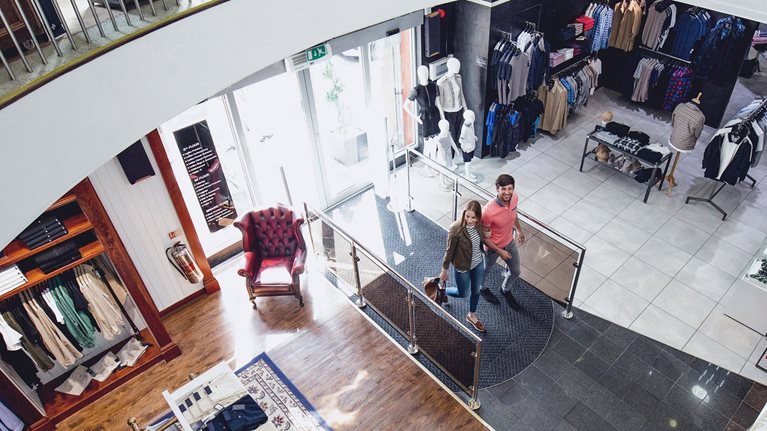The emergence of online retail is transforming the shopping habits of Australian consumers and, as a consequence, will profoundly impact traditional brick and mortar retailers. The entry and growth of e-commerce platforms—retailers that exist predominantly or exclusively online and sell a combination of third party and private label products—is helping to drive this change. The disruption is self-reinforcing: as more consumers migrate to digital channels companies will invest in improving their digital offerings, creating a better experience, resulting in higher levels of customer migration from brick and mortar to digital.
Despite these market conditions, many retailers continue to increase selling space in the hopes of maintaining top line growth. In fact, the pace of growth in selling space has accelerated over the past five years (Exhibit 1). This continued growth in the face of an inevitable decline in foot traffic is potentially explained by an “optimism bias”, where individual players believe they are somehow immune to market conditions that are likely to impact everyone. Nevertheless, traditional Australian brick and mortar retailers will have to face the challenge that so many retailers in developed countries are already grappling with: how to survive a retail landscape marked by the paradox of shrinking (physical space) to grow (overall sales and profit).

The five-year view: Holders and shrinkers
We set out to predict what the Australian brick and mortar retail market will look like in five years by forecasting the need for space across eight major retail sub-categories. Four factors drive the need for physical space: population growth, store productivity growth, transaction intensity and the share of online. The first two are relatively predictable long-term, so we held them constant. The latter two vary significantly, so we tested low, mid, and high cases based on a combination of Australian historical analysis and trends from six comparable retail markets.
Over the next 5 years, we expect the need for selling space to decline by more than 10 percent in the mid case for some categories. Of course, these estimates are sensitive to assumptions, meaning retailers need an eagle eye on how online penetration and transaction intensity evolve. The major retail categories are divided into two groups, each with distinctive product characteristics and consumer behaviours: the “holders”—where we forecast an increase in the need for space—and the “shrinkers”—where we forecast a decline in need for space (Exhibit 2).

Holders
There is reason for some retail categories to be optimistic, and we classify these as the holders. We forecast their need for selling space to increase by 2024—in some instances by a total of more than 5 percent in the mid case. This group includes modern grocery, health and beauty, home improvement, and electronics and appliances. In those categories, consumers are more likely to shop in store versus online, as supported by McKinsey’s proprietary research into online shopping trends in Australia in 2019: 85 percent of Australians are more likely to shop in store for groceries; 75 percent to buy supplies for a DIY project; 72 percent to replace their TV. For these products, our research shows that stores still offer what online cannot: shoppers prefer to see and feel the merchandise (for example beauty, gardening products), and value stores for sales advice (electronics, home improvement). While these categories are likely to maintain selling space, the format of stores may change to better cater to customer missions, for example, by shifting to smaller format stores in high-foot traffic locations. However, in some standardised holder sub-categories such as cleaning products, non-perishables, and electronic media/games, high online penetration is more likely, which may result in a decline in the space allocated for these sub-categories.
Would you like to learn more about our Retail Practice?
Shrinkers
For the categories classified as shrinkers, we forecast selling space to decrease by up to 10 percent in the mid case by 2024. This group includes homewares and home furnishings, leisure and personal goods, apparel and footwear and department stores. In these categories, e-commerce players offer strong benefits to consumers versus stores, through convenience and endless aisles. This is supported by our research: 56 percent of shoppers say online is more convenient than stores, and 62 percent say online has a better product range than stores. This is accelerating customer migration to online channels. As a result, shrinkers’ store footprints will decline if they follow their category projections and do not steal market share from competitors. This means that for the shrinkers, growing selling space would imply that they either believe they can grab an outsized share of the market, or that selling space in their category will grow faster than currently forecasted. Given the former cannot be true for all players and the latter is unlikely to be true based on our analysis, we believe that many retailers in these shrinker categories may see negative impacts from this optimism bias.
A survival plan: Physical space and beyond
So, what moves can retailers be thinking about to ensure they get their physical space right? Our experience suggests there are a set of four key focus points retailers can act on now.
1. Use precision analytics on space; guesstimating is no longer good enough
Forecasting selling space demands a granular, quantitative analysis. To do this, we suggest using a four-step process: diagnose the current state, model the future state, run scenarios and optimise the footprint. The result of the first three steps should be a detailed forecast of selling space by physical space and stores, with scenarios based on consumer behaviours (for example, online penetration) and financial metrics (transaction intensity). The analysis should enable retailers to recalibrate aspirations and inform decisions around where to build, re-design, downsize, and if necessary, exit.
2. Give customers a reason to get off the couch and into stores
Retailers should refresh format strategies to meet shopping missions while also pivoting stores to become a destination. This could be achieved by engaging customers through in-store experiences, services or a distinctive offering. Once the format is defined, size of stores should relate to role of stores.
For example, many retailers are experimenting with the idea of showroom stores that allow customers to touch and feel products, but with limited stock on hand. Sales are completed through online channels while customers are in the store, and the goods are delivered. In addition, as the need for macro space declines, retailers can look to adjust their micro space allocation to complementary services in store (potentially via concessions).
3. Be nimble and control the costs of pivoting
Capital management should be a focus for retailers: where relevant, refurbs should be favoured over new stores; new formats should be experimented and tested before being scaled. If pilots are positive and conclusive, then concepts can be rolled out more widely. In particular, we also recommend testing the limits of small store formats quickly, as this will be inherently capital light, e.g., store-in-store, pop-ups, kiosks, even next-generation vending machines.
4. Run the footprint transformation like … a transformation
Classic transformation principles are required for a successful footprint transformation; this includes, but is not limited to, strict project governance, CEO oversight and early milestone warnings. Also, skilled resources are needed for the tactical (such as lease negotiations) and strategic elements (store formats).
If other transformation initiatives are underway, then retailers should fold these space initiatives into that broader program. If a transformation has not commenced, then retailers should establish a world-class transformation engine, and provide the business with the necessary support and coaching required to enable this once in a generation effort to transform the organisation’s store footprint.
Of course, these four actions speak to the challenge and opportunity of space, but space is not the whole story of retail renewal in Australia. We see four areas of focus beyond physical space.
Double-down on omni
Since there is no reversing customer migration to digital, a token website will no longer suffice as shopper expectations continue to rise. The costs of digital retailing continue to rise with said expectations, and retailers need to be realistic about what to build versus what to outsource, while assessing if partnering (for instance, with an online retail platform) is an option.

Perspectives on retail and consumer goods
Get to world-class analytics, not just ‘better than excel’
Retailers must invest in data and analytics capabilities to derive value across a number of priority use cases (for example, cross-sell or up-sell). Achieving this at pace and scale requires a Centre of Excellence and the recruitment of talented data-scientists.
Strip costs out aggressively
Continuous cost improvement is instrumental to funding digital innovations and core capabilities. Experience indicates that an approximate 10 percent savings on addressable costs is achievable even for leading retailers.
Be on the lookout for M&A(&D) opportunities
Scale still pays (via, for example, leveraging new categories). With the prevalence of omni, digital costs will grow, and retailers should look to fractionalise this spend.
As online retail continues to transform the shopping habits of Australian consumers, the decline in need for space is posing a challenge to Australian brick and mortar retailers. Our assessment is that—on average—the sector is underreacting, so the time to act is now, to avoid an Australian retail ghost town.


